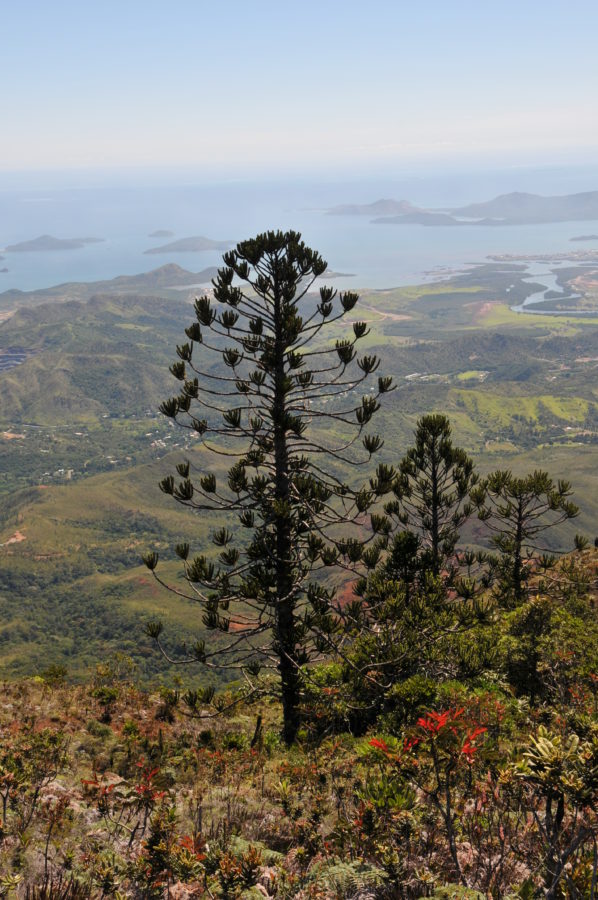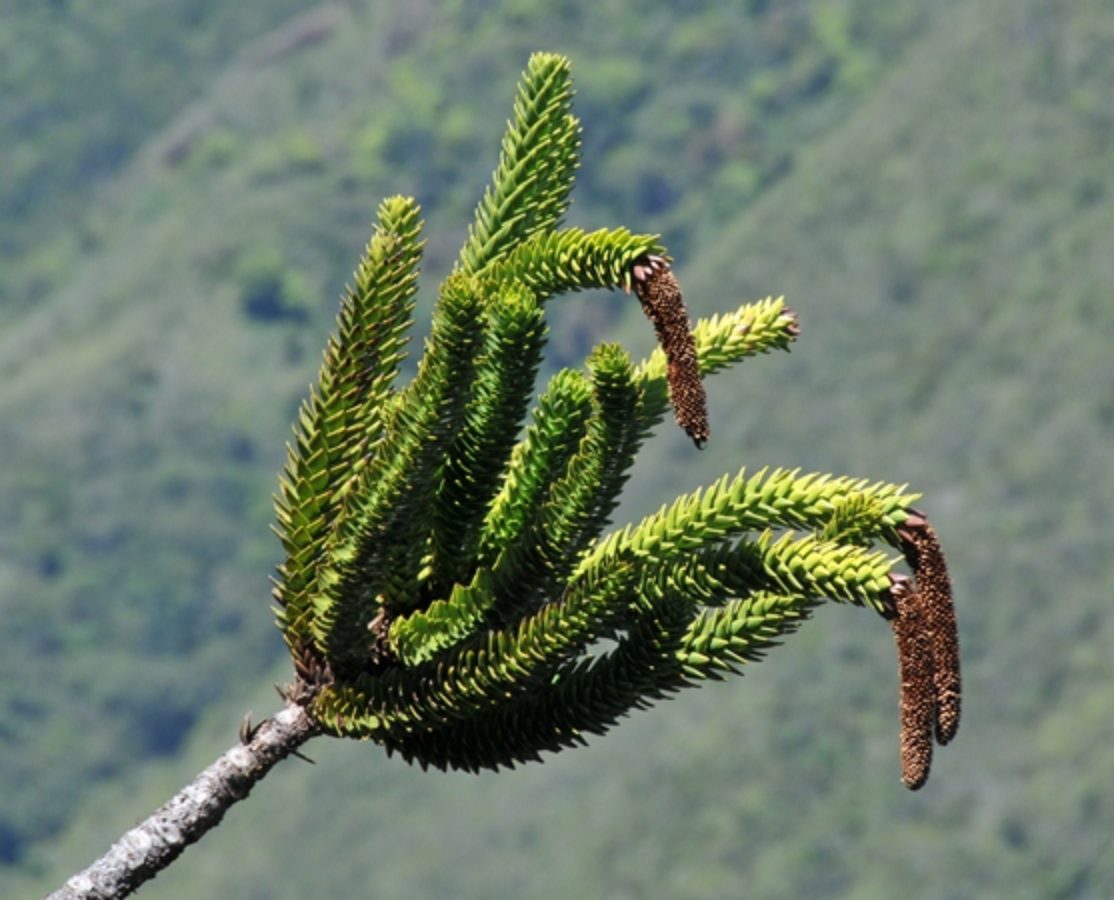Araucariaceae
Araucaria muelleri
One of 13 species of Araucaria endemic to New Caledonia where it has a restricted distribution and has become Endangered due to mining and fire.
Description
Habit
A monoecious tree up to 20m tall, with a d.b.h. up to 0.8m at maturity. Pyramidal when young and developing a very distinct open, candelabriform crown as it matures. The thick bark is light grey or reddish-grey, often almost white, peeling in horizontal plates.
Foliage
Adult leaves lanceolate to ovate with an obtuse apex, 2–3 x 1–2cm.
Cones
Male pollen-cones terminal, up to 25cm long, mature early July (variant with lustrous leaves), or in September to December (typical form). Female seed-cones terminal on very short branches, mature cones broadly ovoid, up to 15cm long; bracts with prominent long tips. Young female cones appear in October, mature cones appear in March.
Key characters
A. muelleri has the largest adult leaves of any New Caledonian Araucaria species (up to 35mm in length). The stomata on the underside of adult leaves are numerous and scattered along the length. The almost white bark, the trunk with lax, long, horizontally spreading primary branches always in whorls of 4, and the candelabra-shaped crown also distinguish this species. In certain parts of its range (e.g. Goro Plateau and Mamie) a variant occurs that only has a few stomata at the base of the adult leaves so that it resembles a very large leafed A. rulei.
References and further reading
- Cornu, A., Sarrailh, J.-M. & Marion, F. (2001). Espèces endémiques et restauration écologique en Nouvelle-Calédonie. Bois Et Forêts Des Tropique 268(2): 57-68.
- de Laubenfels, D. J. (1972). Gymnospermes. In: Aubréville, A. & Leroy, J.-F. (eds.), Flore de la Nouvelle-Calédonie et Dépendances, 4. Paris: Muséum National d’Histoire Naturelle. 167 p.
- Enright, N., B.P. Miller, G.L.W. Perry, D. Goldblum, T. Jaffre (2014). Stress-tolerator leaf traits determine population dynamics in the endangered New Caledonian conifer Araucaria muelleri. Austral Ecology 39:60-71.
- Gaudeul, M., Rouhan, G., Gardner, M.F. & Hollingsworth, P.M. (2012). AFLP markers provide insights into the evolutionary relationships and diversification of New Caledonian Araucaria species (Araucariaceae). American Journal of Botany 99(1):68-81.
- Jaffré, T., Munzinger, J. & Lowry, P.P. (2010). Threats to the conifer species found on New Caledonia's ultramafic massifs and proposals for urgently needed measures to improve their protection. Biodiversity & Conservation: 19(5):1485-1502.
- L'Huillier, L. Jaffré, T. & Wulff A. (2010). Mines et environnement en Nouvelle-Calédonie : les milieux sur substrats ultramafiques et leur restauration. Editions IAC, Nouméa, Nouvelle-Calédonie, 412 p.
- Manauté, J., Jaffré, T., Veillon, J.-M. & Kranitz, M. (2003). Revue des Araucariaceae de Nouvelle-Calédonie. IRD, Nouméa.
- Mazzeo, F. (2004). Exploitation minière et valorisation du patrimoine floristique de Nouvelle-Calédonie. Contribution à l’élaboration d’un guide pratique de reboisement des terrains miniers du Grand Sud (Sud de la ligne Mont-Dore –Yaté). Saint Denis: Université de La Réunion / Noumea: IRD. 75 pp.
- Nasi, R. (1982). Essai pour une meilleure connaissance et une meilleure comprehension des Araucariacées dans la végétation Calédonienne. Nouméa: École Nationale des Ingénieurs des Travaux des Eaux et Forêts, Centre Technique Forestier Tropical. 134 p., 10 plates, 44 p. appendices.
- Sarrailh, J. M. & Ayrault, N. (2001). Rehabilitation of nickel mining sites in New Caledonia. Unasylva 52 (207): 16–20.
- Thomas, P. (2010). Araucaria muelleri. In: IUCN 2012. IUCN Red List of Threatened Species. Version 2012.1. www.iucnredlist.org. Downloaded on 29 June 2012.











